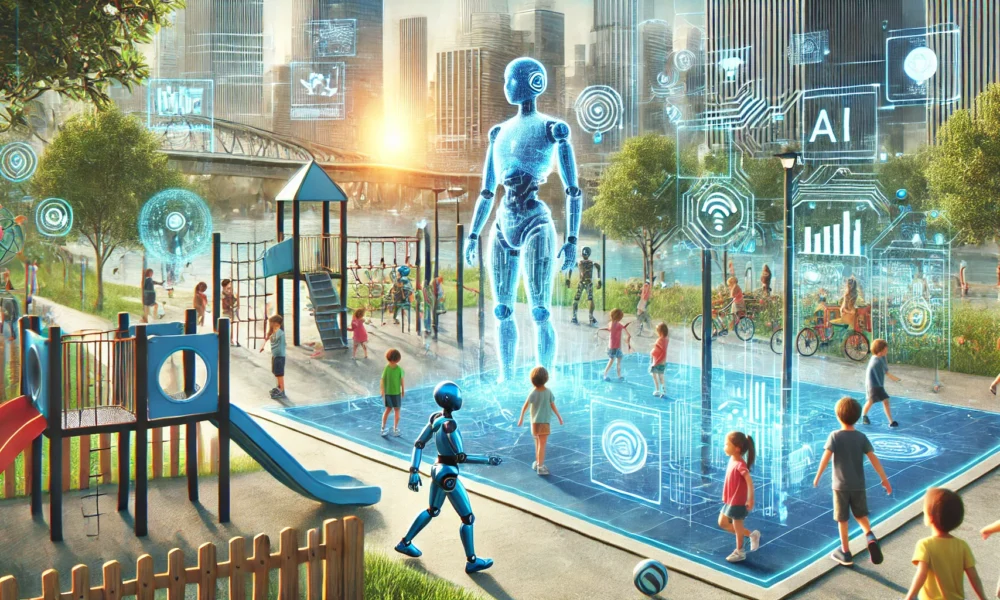Generative AI has gained significant traction due to its ability to create content that mimics human creativity. Despite its vast potential, with applications ranging from generating text and images to composing music and writing code, interacting with these rapidly evolving technologies remains daunting. The complexity of generative AI models and the technical expertise required often create barriers for individuals and small businesses who could benefit from it. To address this challenge, generative AI playgrounds are emerging as essential tools for democratizing access to these technologies.
What is Generative AI Playground
Generative AI playgrounds are intuitive platforms that facilitate interaction with generative models. They enable users to experiment and refine their ideas without requiring extensive technical knowledge. These environments provide developers, researchers, and creatives with an accessible space to explore AI capabilities, supporting activities such as rapid prototyping, experimentation and customization. The main goal of these playgrounds is to democratize access to advanced AI technologies, making it easier for users to innovate and experiment. Some of the leading generative AI playgrounds are:
- Hugging Face: Hugging Face is a leading generative AI playground, especially renowned for its natural language processing (NLP) capabilities. It offers a comprehensive library of pre-trained AI models, datasets, and tools, making it easier to create and deploy AI applications. A key feature of Hugging Face is its transformers library, which includes a broad range of pre-trained models for tasks such as text classification, translation, summarization, and question-answering. Additionally, it provides a dataset library for training and evaluation, a model hub for discovering and sharing models, and an inference API for integrating models into real-time applications.
- OpenAI’s Playground: The OpenAI Playground is a web-based tool that provides a user-friendly interface for experimenting with various OpenAI models, including GPT-4 and GPT-3.5 Turbo. It features three distinct modes to serve different needs: Chat Mode, which is ideal for building chatbot applications and includes fine-tuning controls; Assistant Mode, which equips developers with advanced development tools such as functions, a code interpreter, retrieval, and file handling for development tasks; and Completion Mode, which supports legacy models by allowing users to input text and view how the model completes it, with features like “Show probabilities” to visualize response likelihoods.
- NVIDIA AI Playground: The NVIDIA AI Playground allows researchers and developers to interact with NVIDIA’s generative AI models directly from their browsers. Utilizing NVIDIA DGX Cloud, TensorRT, and Triton inference server, the platform offers optimized models that enhance throughput, reduce latency, and improve compute efficiency. Users can access inference APIs for their applications and research and run these models on local workstations with RTX GPUs. This setup enables high-performance experimentation and practical implementation of AI models in a streamlined fashion.
- GitHub’s Models: GitHub has recently introduced GitHub Models, a playground aimed at increasing accessibility to generative AI models. With GitHub Models, users can explore, test, and compare models such as Meta’s Llama 3.1, OpenAI’s GPT-4o, Cohere’s Command, and Mistral AI’s Mistral Large 2 directly within the GitHub web interface. Integrated into GitHub Codespaces and Visual Studio Code, this tool streamlines the transition from AI application development to production. Unlike Microsoft Azure, which necessitates a predefined workflow and is available only to subscribers, GitHub Models offers immediate access, eliminating these barriers and providing a more seamless experience.
- Amazon’s Party Rock: This generative AI playground, developed for Amazon’s Bedrock services, provides access to Amazon’s foundation AI models for building AI-driven applications. It offers a hands-on, user-friendly experience for exploring and learning about generative AI. With Amazon Bedrock, users can create a PartyRock app in three ways: start with a prompt by describing your desired app, which PartyRock will assemble for you; remix an existing app by modifying samples or apps from other users through the “Remix” option; or build from scratch with an empty app, allowing for complete customization of the layout and widgets.
The Potential of Generative AI Playgrounds
Generative AI playgrounds offer several key potentials that make them valuable tools for a wide range of users:
- Accessibility: They lower the barrier to entry for working with complex generative AI models. This makes generative AI accessible to non-experts, small businesses, and individuals who might otherwise find it difficult to engage with these technologies.
- Innovation: By providing user-friendly interfaces and pre-built models, these playgrounds encourage creativity and innovation, allowing users to quickly prototype and test new ideas.
- Customization: Users can readily adopt generative AI models to their specific needs, experimenting with fine-tuning and modifications to create customized solutions that serve their unique requirements.
- Integration: Many platforms facilitate integration with other tools and systems, making it easier to incorporate AI capabilities into existing workflows and applications.
- Educational Value: These platforms serve as educational tools, helping users learn about AI technologies and how they work through hands-on experience and experimentation.
The Challenges of Generative AI Playgrounds
Despite the potential, generative AI platforms face several challenges:
- The primary challenge is the technical complexity of generative AI models. While they aim to simplify interaction, advanced generative AI models require substantial computational resources and a deep understanding of their workings, especially for building custom applications. High-performance computing resources and optimized algorithms are essential to improve response and usability of these platforms.
- Handling private data on these platforms also poses a challenge. Robust encryption, anonymization, and strict data governance are necessary to ensure privacy and security on these playgrounds, making them trustworthy.
- For generative AI playgrounds to be truly useful, they must seamlessly integrate with existing workflows and tools. Ensuring compatibility with various software, APIs, and hardware can be complex, requiring ongoing collaboration with technology providers and adherence to new AI standards.
- The rapid pace of AI advancements means these playgrounds must continuously evolve. They need to incorporate the latest models and features, anticipate future trends, and adapt quickly. Staying current and agile is crucial in this fast-moving field.
The Bottom Line
Generative AI playgrounds are paving the way for broader access to advanced AI technologies. By offering intuitive platforms like Hugging Face, OpenAI’s Playground, NVIDIA AI Playground, GitHub Models, and Amazon’s Party Rock, these tools enable users to explore and experiment with AI models without needing deep technical expertise. However, the road ahead is not without hurdles. Ensuring these platforms handle complex models efficiently, protect user data, integrate well with existing tools, and keep up with rapid technological changes will be crucial. As these playgrounds continue to develop, their ability to balance user-friendliness with technical depth will determine their impact on innovation and accessibility.






